
Everglades park celebrates 60th birthday
FLORIDA CITY, Fla.— When President Harry Truman dedicated Everglades National Park on an historic Saturday, Dec. 6, 1947 – 60 years ago this December – he marked the end of a long, complicated process– including survey expeditions, committee investigations and negotiations over oil rights – that consumed much of the first half of the 20th century.
For the first white settlers who trickled into Miami in the late 1800s, what later became known as the “River of Grass” was little more than a large, nasty swamp with little innate value – and no need for preservation.
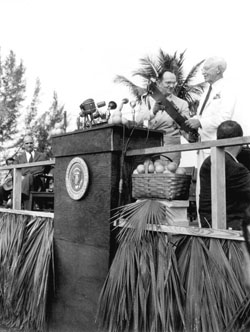 |
The dedication of Everglades National Park, Saturday, Dec. 6, 1947, in Everglades City, Fla. (Florida Photographic Collection, State Archives of Florida). |
“They thought, ‘Let’s drain the swamp and make it something useful,’” Nancy Russell, museum curator for the Everglades National Park’s South Florida Collection Management Center archive in Homestead, said. “‘We need to drain it to make it useful for agriculture or something else.’ The idea of recognizing the value of the Everglades as a natural resource did not come until later.”
The core of what we now know as Everglades National Park began as Royal Palm State Park, dedicated on Nov. 22, 1916. The Florida state park was administered by the Florida Federation of Women’s Clubs, which, in time, found that it could not handle the task of administering the area all by itself.
“They were having difficulty getting enough money to continue,” Russell said. “They needed additional funds.”
In the early 1920s, the federation tried to interest the Florida Legislature in expanding the park and giving it to the National Park Service. The legislature granted only a fraction of the 12,000 acres that the federation wanted. Undeterred, the federation offered the park, with its original boundaries, to the park service.
|
Everglades conservationist Marjory Stoneman Douglas, as she appeared in 1985 (Photo courtesy of the Florida Photographic Collection, State Archives of Florida). |
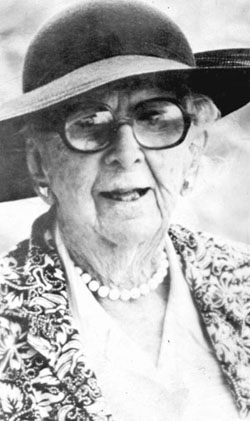 |
In 1923, the director of the National Park Service, Stephen B. Mather, recommended to the secretary of the Interior that a survey be made of the entire United States for areas of “extraordinary quality” that might warrant preservation. He mentioned the Everglades as one such area.
Meanwhile, other interested groups, most notably the Audubon Society – whose game warden saw a need to protect the park’s diverse bird population – came together to lobby the National Park Service.
Russell cited Ernest Coe, a landscape architect, as one of the earliest and most influential advocates of protecting the Everglades.
“He was very impressed with the natural beauty of the area,” Russell said. “He wanted to find some way to protect the resources from the developers.”
Coe and his allies launched a nationwide public-relations campaign to champion the idea of dedicating a national park in South Florida.
“They did a lot of public-speaking events,” Russell said. “They brought in scientists and other well-known people. They had dignitaries from the National Park Service. Anyone and everyone who they felt could help the cause got involved.”
They faced considerable opposition from many quarters – local residents, businessmen and others who felt the area did not “deserve” to be a national park, Dr. Gregory W. Bush, a University of Miami history professor, said.
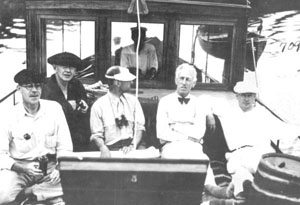 |
Ernest F. Coe, “Father of the Everglades,” appears fourth from the left in this photograph from April 1929 (Photo courtesy of the Florida Photographic Collection, State Archives of Florida). |
“At the time, people thought national parks were majestic, like Yosemite,” Bush said. “At first, the Everglades didn’t fit into the vision of what national parks were. They seemed strange and swamp-like.”
A key ally in Coe’s fight was the now-legendary Marjory Stoneman Douglas. Although Douglas’ famous book, River of Grass, did not appear until 1947, she used her position of influence as a Miami Herald columnist in the 1920s and 1930s to raise public awareness of the Everglades’ plight.
“She was able to get the value and the sense of the Everglades out to people in a different way from the committee’s work of trying to get the park established,” Russell said. “She was able to popularize the Everglades.”
“A lot of different people were interested in the Everglades for different reasons,” Russell added. “There were people who were concerned about the drainage that was happening, and about the bird life. A lot of forces favoring conservation converged to create the park.”
That process of convergence did not yield concrete results until 1928, when U.S. Sen. Clark Trammel of Florida introduced legislation calling for an investigation of the park to determine its eligibility for national-park status.
Congress authorized turning the Everglades into a national park in 1934, over the objections of many who thought protecting the environment would spell economic catastrophe for the region.
A Tropic Everglades National Park Committee, consisting of Coe, Douglas and other prominent South Floridians, considered such matters as boundaries, land acquisition and funding. The committee worked for 13 years to overcome problems, including the discovery of oil on land that Coe originally wanted for Everglades National Park.
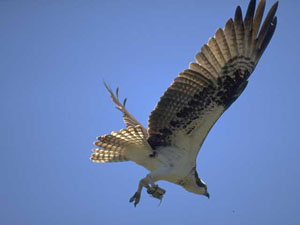 |
Many of the earliest backers of an Everglades National Park sought to protect the region’s numerous bird species (Photo courtesy of the Friends of the Everglades). |
The oil-bearing land did not become part of Everglades National Park, but it was incorporated into Big Cypress National Park in 1980.
In her 1990 autobiography, Voices of the River, Douglas wrote that Coe deserved the credit for turning his dream into reality.
“He never got enough recognition,” she wrote. “There ought to be a memorial to him out there.”
In a sense, Douglas’ wish came true in December 1996, when Everglades National Park dedicated the state-of-the-art Ernest F. Coe Visitor Center at the entrance to the park. The original visitor’s center succumbed to the ravages of Hurricane Andrew in August 1992.
The final authorization for Everglades National Park came in December 1945. In June 1947, a last-minute effort by Florida’s attorney general to delay the dedication over a dispute about “customary royalties” died in the courts.
Six months later, after nearly three decades of struggle, President Harry Truman stood on a palmetto-thatched platform and spoke to a crowd estimated at 10,000 people near the historic Rod and Gun Club in Everglades City.
“Here are no lofty peaks seeking the sky, no mighty glaciers or rushing streams, wearing away the uplifted land,” Truman said. “Here is land, tranquil in its quiet beauty, serving not as the source of water, but as the last receiver of it. To its natural abundance we owe the spectacular plant and animal life which distinguishes this place from all others in our country.”
For Gregory Bush, the importance of protecting the Everglades remains as clear now as it did 60 years ago.
| An Everglades sunset (Photo courtesy of the Friends of the Everglades). | 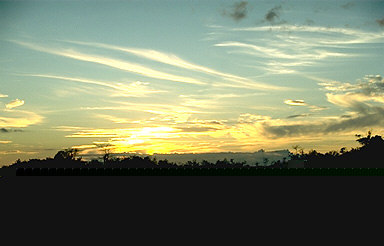 |
“The Everglades is linked to water, growth and the way people live,” Bush said. “It seems so abstract, but it’s very, very important. People need to get over and see it more, appreciate it.”
As of April 2007, officials at Everglades National Park planned activities to celebrate the upcoming 60th anniversary of the park’s dedication.
“The event would be sometime in December,” Linda Friar, public information officer for Everglades National Park, said.

Comments are Closed